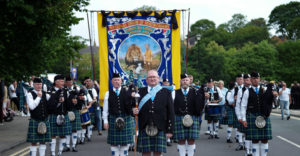Geordies, it is said, “have long wished to be Vikings”. So some among us might have looked north with envy last week. It’s not often that Orcadian irredentists make international headlines, but the suggestion that the Orkneys might be reunited with Norway has rekindled interest in Britain’s Scandinavian past. “We were part of the Norse kingdom for much longer than we were part of the United Kingdom,” noted the island’s council leader, James Stockan. The same cannot be said of North East England, but the kinship felt across the choppy North Sea remains powerful, having recurred down the centuries.
It is little-known that in 1642, the Scots-born King Charles I — increasingly desperate for resources to prosecute his war against parliament — asked his uncle, King Christian IV of Denmark-Norway, for military aid. In return, the Danes wanted the Orkneys, the Shetlands, and to “gain possession of Newcastle in pawn”. It was Northumbria’s lucrative coal trade that appealed. A large shipment of weapons and supplies duly arrived at Holy Island in September 1642, but it is unclear whether Charles ever paid his uncle back. The Danish king certainly didn’t seize the collateral on his loan.
Had he done so, there would have been a precedent. Holy Island was the site of a rather less peaceable Danish excursion in 793, when the Vikings sacked Lindisfarne, possibly in retribution for Christian missionary activity in Scandinavia. They were undoubtedly also itching to get their hands on the great wealth of the Northumbrian church. “The church of St Cuthbert is spattered with the blood of the priests of God,” lamented a Bishop of Lindisfarne, “stripped of all its furnishings, and exposed to the plundering of pagans.” The shock of this event cast a long shadow in the North East, perhaps partly explaining the overemphasis of Scandinavia’s influence on Northumbrian history, and its people.
True, the Viking raids are depicted in William Bell Scott’s great cycle of Northumbrian history murals at Wallington Hall, and Nordic influence can seemingly still be detected in Northumbrian speech. The similarities between the Scandinavian “gå hjem” and Northumbrian “gan yem” — both expressions meaning “go home” — seem obvious. The Dano-Norwegian word for barley, “bygg“, lives on in the name of Newcastle’s famous Bigg Market. These linguistic parallels might suggest Scandinavian roots, but such words are not so much a Viking import as an indication that Northumbria’s is a very conservative English dialect, which shares a common Germanic root with modern Danish. For the Angles that first settled in Britain, after the Romans left, came from Angeln, in the southern part of the Jutland peninsula, where the borders of Germany and Denmark now meet. These Angles established the kingdoms of Deira, centred in what is now Yorkshire, and then Bernicia, in what is now Northumberland and County Durham.
When the Vikings came along a few centuries later, they became infamous for raiding the North East coast. But the Norsemen only tended to settle further south, around the great city of Jorvik and into the Midlands. To this day, members of the Yorkshire Society recite a Declaration of Integrity, which asserts the traditional boundaries of Yorkshire, established by Halfdan Ragnarsson in 875AD. But to the North, the Anglo-Saxons centred on the old kingdom of Bernicia remained unconquered by the invaders (or at least not settled). It is certainly noticeable how all those Scandinavian “-thorpes”, “-thwaites” and “-bys” scattered across Yorkshire and Lincolnshire peter out at the river Tees. Here, the Anglo-Saxon “-worth” is more conspicuous: Backworth, Heworth, Killingworth. Indeed, for a time in the ninth and tenth centuries, the rump of Anglo-Saxon Northumbria between the Tweed and Tees may even have become a centre of resistance against the Vikings.
A teleological version of English history would have it that the mission to unify the patchwork of Anglo-Saxon kingdoms was inevitable — first under Alfred and then his grandson Æthelstan, with the latter the first to call himself “King of the English”. But this unity did not long survive Æthelstan’s death in 939. For Scandinavian loyalty had remained potent across the “Danelaw” areas of the North, the northern Midlands and East Anglia. In fact, when the Danish King Cnut invaded in 1014, he met so many sympathisers that England was quickly added to his empire. As James Hawes has observed, “the first united ‘England’ was thus created under colonial rule”. And given this disunity, it is not surprising perhaps that William of Normandy “conquered the entire country after a single major battle in 1066, an outcome that would have been much less likely if Anglo-Scandinavian ‘Englalonde’ had in fact been the ancient, united realm of some historians’ fantasies”.
After 1066, overt Scandinavian political influence in England declined rapidly, with only traces left. The word hustings, for instance, derives from the Old Norse “hústhing” — in other words, a “household assembly held by a leader” — from “hús” (house) plus “thing’ (assembly, parliament). In fact, there remain several “Things” across the Nordic world — from the Folketing (“People’s Thing”) in Denmark, to the Storting (“Great Thing”) in Norway, to the Tynwald (“Thing Meadow”) on the Isle of Man — probably the oldest continuous parliamentary body in the world.
The picture was different in Scotland, where Norwegian overlordship of the western isles persisted until the 13th century. A few hundred years later, in the early modern period, Scottish mercenaries distinguished themselves in the service of Gustavus Adolphus of Sweden. Norwegian partisans actually fought off a Scottish invasion of their homeland in 1612. And even after Scotland unified with England in 1707, the Nordic kingdoms remained serious geopolitical rivals — to the extent that, in 1717, the Swedish Foreign Ministry planned to send an invading force to Scotland in support of the Jacobite cause.
Admittedly, this might have been to counter the Hanoverian George I’s designs on Swedish territory in Northern Germany. Britain as a whole was not sentimental about Scandinavia. In the Napoleonic Wars, Britain ruthlessly attacked Denmark twice to ensure the Danish fleet did not fall into French hands: first in 1801 (“I really do not see the signal,” said Nelson, ignoring his commander’s orders to withdraw from the bombardment of Copenhagen); and again in 1807, when the Danish capital was occupied by British troops, including Sir Arthur Wellesley, who named his famous horse after the battle.
The 19th century saw the Scandinavian kingdoms gradually withdraw from great power politics. The Second Schleswig War of 1864 is usually seen as the first key staging post in German unification, but it was also the twilight of Scandinavian power in Europe. Palmerston’s much-quoted quip about the Schleswig-Holstein Question being so complicated that “only three people ever understood it” was probably just blether to obscure the fact that Britain had (probably wisely) betrayed a solemn promise to maintain Danish territorial integrity, and instead decided to sit out the war between Denmark and its Prussian and Austrian invaders. For proud Danes such as the British Queen Alexandra, the humiliation of 1864 was hard to forgive or forget. She always railed against the protocols that required her son, George V, to dress as a “filthy blue-coat Prussian soldier” whenever he visited the new German Empire.
But with the bloody rivalries of the Dark Ages now ancient history, relations between the British and Scandinavian royal houses grew increasingly cordial. Queen Alexandra’s daughter Maud became the Queen of newly independent Norway after its separation from Sweden in 1905. And harking back to the Viking Kings of East Anglia, Maud’s own son Olav was born in Norfolk — at Sandringham in 1903. Olav’s birth came after a long period of deepening Anglo-Scandinavian trade: the housebuilding boom in British cities relied on Norwegian and Swedish softwoods, and Scandinavian timber was essential to the coal trade, used for pit props and railway sleepers. Danish butter and bacon became staples of the British breakfast table. Many British port towns and cities had great Scandinavian churches, like the spectacular Gustav Adolfs kyrka in Liverpool, home of the Scousers, and the Nordic diaspora gave us Cardiff’s Roald Dahl, Newcastle’s Sir Ove Arup, and hat-trick hero Stan Mortensen from South Shields, the grandson of a Norwegian sailor.
In 1968, King Olav V himself was invited to open the modernist Civic Centre at Newcastle upon Tyne, home of the Danish merchant navy in the Second World War, when 4,000 Danish sailors relocated from their occupied homeland to live on Tyneside. The building was modelled on the Stockholm Stadhus, as a nod to the Tyne’s modern Hanseatic ties. Although the King was attended by Lutheran ministers in 16th-century ruffs and gowns, the civic centre was seen as an emblem of progressive Nordic modernity. This was part of a process that was recasting Scandinavians as peaceable and stylish, representatives of the very best social democracy. But even the darker history of the Vikings, whose cruelty and sadism was almost unsurpassed, has now been rehabilitated through popular books and TV series like The Last Kingdom, in which uptight and sexually repressed Christians are contrasted unfavourably with the fun-loving Norsemen such as the smoulderingly handsome Uhtred of Bebbanburg.
From one of pillage and rapine, Scandinavia’s reputation has completely turned around in the last 1,000 years — but it’s surely their wealth as much as their cultural achievements that attracts us now. As I have argued, “the one thing that will change attitudes to Britishness in Scotland is for the UK to just be a wealthier and more successful country”. Returning to the restive streets of Orkney, it is perhaps not surprising that a territory that was Norse for longer than it was British now wishes to re-establish its Scandi ties. Yet, there was no Orcadian agitation when Britain was richer and more powerful, with a vast fleet at Scapa Flow. The difference now is that, unlike modern Britain, Norway is happy, successful, and stinking rich.
Disclaimer
Some of the posts we share are controversial and we do not necessarily agree with them in the whole extend. Sometimes we agree with the content or part of it but we do not agree with the narration or language. Nevertheless we find them somehow interesting, valuable and/or informative or we share them, because we strongly believe in freedom of speech, free press and journalism. We strongly encourage you to have a critical approach to all the content, do your own research and analysis to build your own opinion.
We would be glad to have your feedback.
Source: UnHerd Read the original article here: https://unherd.com/



